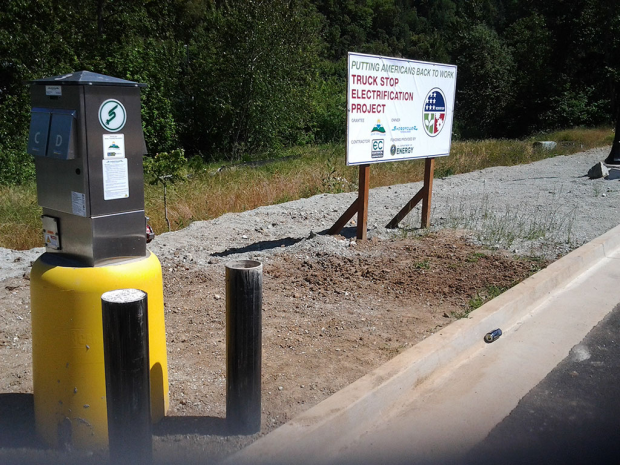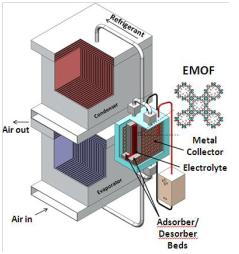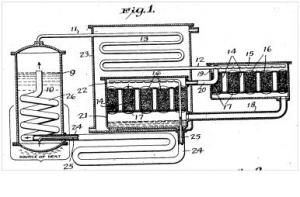Road Trip Thinking
Posted Tuesday, June 26, 2012.
Last week I delivered my daughter to San Francisco by car. Roughly 800 miles each way. Erin landed a summer internship there. The hours on the road got me to thinking. Again.

The Honda Pilot that we took averaged about 20 miles per gallon on the trip. The tank holds 20 gallons. We stopped about every 360 miles to fill the tank. The reckoning for the gas added to about $154.00 each way. Pretty standard stuff.On the Oregon leg, we noticed signs pointing to “EV charging stations” every so often. EV being electric vehicles of course. We stopped at the one in Canyonville, Oregon. A huge parking lot. Lots of charging stations. Not one in use. The same situation on the return trip. Why no activity?
Maybe the infrastructure is way out ahead of the technology. After all, EV car batteries hold little power and have to be recharged for long periods of time every 100 miles or so. So an 11 hour gas engine drive to San Fran would take 11 hours + 8 charges x 8 hours/charge = 75 hours each way. Not very practical. And as a friend once told me, nobody likes to sit in a wicker-basket car seat for the privilege of saving the earth.
Bottom line is that gasoline fuel packs an astounding amount of energy into a gallon. Roughly 114,000 BTU or 33.4 kW-hours. Existing batteries are far weaker. The entire Nissan Leaf battery, for example, holds just 24 kW-hours of energy. I don’t care how efficient you make the car, you are not going to travel very far on 2/3 gallon of gasoline equivalent.
So what to do? Innovate! If an EV car can’t hold much energy, one could design it to have very quick recharging turnaround. Some proposals to build battery-swapping stations are out there. That seems clunky to me. But it might work. Not to restate the obvious, but the industry needs to invent a battery having far higher energy density.
A gamechanger might be to figure out how to power EV cars while they are on the road. Solar cells are weak and impractical. Some other sort of infrastructure, expensive I’m sure, will be necessary to do something like this.I am afraid that the $130 million spent on the West Coast Electric Highway (http://www.oregon.gov/ODOT/HWY/OIPP/inn_ev-charging.shtml) might have been a big waste of resources. EV cars may make some sense in-city for commuting, but highway trips are really impractical.
I’d put my money instead on cleaner fossil fuels. 4 gallons of compressed natural gas, for example, are equivalent to 1 gallon of gasoline. Engineering the increased fuel volume for CNG cars would be much easier in the short run than hoping, praying, for an unexpected EV breakthrough. Just my 2 cents worth.
Life of a Patent Lawyer
Posted Tuesday, June 19, 2012.
Somebody recently offered me a free lunch to tell them about my life as a patent attorney. It got me to thinking.
I entered the patent field right after MBA school. Then, “Barriers to Entry” were a big deal in the competitive world. High barriers mean that potential competitors have a tough time eating into your business. The result is that you keep more of your profits.
Patents and other IP rights seemed to me to be the most effective barrier to entry. Especially for young companies seeking a toehold in the world of tech. So that’s where I headed when the opportunity arose.
I am astounded at how that theory of IP protection plays out today. Mega-companies and startups alike consistently invest their precious capital into developing patent portfolios. The resulting patents are used to attract investment. Or to generate licensing income. Sometimes they are used as a shield to defend against the competitors own patents. Recently, patent portfolios have been wielded to wall off technologies for exclusive use. Nearly every week there is a new development in the patent wars.
My role in this world is in developing the IP portfolio for my clients. Every day I spend some time writing a patent application, trying to describe a new invention to the world. Or I am preparing a response to a Patent Office Action. Or I am working with inventors to figure out the value of their new ideas. The work is complicated. Sometimes it is painfully mundane. But it is always challenging.
Intellectual Property: An Economic Driver in Washington State
Posted Saturday, June 02, 2012.
I hope that you noticed the transition of this blog from Wordpress to the new HalsneLaw.com website. Let’s kick off the year with an eye-opener about the value of IP, as collected from an affiliate of the U.S. Chamber of Commerce called the Global Intellectual Property Center. Some of their statistics appear below.
Intellectual Property (IP), which refers to everything from inventions to the creative arts, drives innovation and improves our lives—generating life saving devices and medicines, discovering new energy and climate-saving technologies, finding novel ways to create and deliver information, and generating consumer goods of all types. IP-intensive industries directly and indirectly employ 55 million Americans, and many of them are in higher-paying jobs and faster-growing fields.• America’s IP is worth $5.8 trillion, more than the nominal GDP of any other country in the world.• IP accounts for 74% of all U.S. exports- which amounts to nearly $1 trillion.• America is a net exporter of IP, contributing $37 billion to our 2006 trade balance.
Washington state relies heavily on IP in its $64.6 billion annual exports. IP supports almost half of the state’s 2.5 million private sector jobs. And IP-intensive companies generate 90% more economic output per employee than the average.
These statistics indicate that the value of IP to Washington businesses is substantial. It is well worthwhile to consider how to protect the IP in yours.
Mayo Collaborative Services v. Prometheus Laboratories, Inc. and the Boundaries of Patentability
Posted Thursday, March 29, 2012.
What with all the hoopla surrounding the Supreme Court hearings this week on the Affordable Care Act, it’s timely to comment a bit on its ruling issued last week about patents. For the second time in two years, the Supremes have weighed in on the idea of what kinds of things, exactly, are patentable. And this time (unanimously!) they outlined its limits. http://www.supremecourt.gov/opinions/11pdf/10-1150.pdf
Section 101 of the Patent Act defines patentable material as “any new and useful process, machine, manufacture, or composition of matter, or any new and useful improvement thereof.” Purely laws of nature, natural phenomena, and abstract ideas are not patentable. The definition worked well for many years.
But advances in technology have raised questions about whether things like methods of doing business and the manipulation of genes in organisms fall within the Patent Law. Technologies like these are a big part of innovation in the Pacific Northwest, so the issue of patent protection for them is important to us.
Two Prometheus patents for a method of optimizing a drug therapy were challenged by Mayo. A typical claim in the patents included just two basic steps: administering the drug, and determining the level of metabolites in the patient caused by the administered drug. Mayo argued that Prometheus was merely trying to patent a law of nature. Prometheus argued that the steps were an application of a law of nature, which is patentable.
The Supreme Court sided with Mayo. They reasoned that:
“A patent, for example, could not simply recite a law of nature and then add the instruction “apply the law.” Einstein, we assume, could not have patented his famous law by claiming a process consisting of simply telling linear accelerator operators to refer to the law to determine how much energy an amount of mass has produced (or vice versa). Nor could Archimedes have secured a patent for his famous principle of flotation by claiming a process consisting of simply telling boat builders to refer to that principle in order to determine whether an object will float.”
The Supremes rejected the Prometheus claims as a law of nature (i.e. the human response to an administered drug) with the words “apply it.” They held that the patented method step of determining that response added nothing significant to the law of nature.
Innovators in the digital technology and biotechnology arenas should take careful note. Before investing in patent protection for an idea that applies a law of nature, carefully identify how your invention may apply a law of nature. If the “apply” part is new and useful, you have taken the first step toward avoiding the “Prometheus trap.”
Molecular Heat Pump for Electric Vehicles
Posted Tuesday, March 13, 2012.
Pacific Northwest National Laboratory researchers will lead three projects whose $3.8 million funding was announced this week by the Department of Energy’s Advanced Research Projects Agency for Energy. The projects are aimed at dramatically improving how the U.S. produces and uses energy. One of these projects is aimed at achieving more efficient heating and cooling of electric vehicle cabins.
Internal combustion engines in today’s cars generate a lot of heat, which is great for heating the passenger cabin in winter. Electric vehicles produce very little waste heat, so providing electricity for the same amount of heat would reduce their driving range by as much as 40 percent. PNNL scientists Pete McGrail and Praveen Thallapally, and University of South Florida chemists Mike Zaworotko and Ma Shengqian will receive $800,000 to develop a material called an electrical metal-organic framework, or EMOF for short, for vehicle heating and cooling systems. The EMOF would work as a molecular heat pump, which efficiently circulates heat or cold as needed. By directly controlling the EMOF’s properties with electricity, their design is expected to use much less energy than traditional heating and cooling systems. For example, a 5-pound EMOF-based heat pump the size of a 2-liter bottle could theoretically handle the heating and cooling needs of an electric vehicle with far less impact on driving distance.
http://arpa-e.energy.gov/LinkClick.aspx?fileticket=HCoBAliXXWE%3d&tabid=525
This type of heat pump appears to be a variation on a century-old absorption refrigeration technology, which required no refrigerant gas compressor but was largely abandoned for being bulky and difficult to operate efficiently. An early patent, 1920612, was awarded to Platen and Munters in 1933. The technique works by transporting refrigerant into and out of a liquid solution (the absorber) across a pressure gradient. The Platen-Munters patent describes the process well.
Platen-Munters Patent 1,920,612
The PNNL work appears to be focused on the EMOF bed as a means to overcome the limitations of the earlier devices. If the result is much higher efficiency, it would be very widely applicable. For example, about 15% of all electricity usage in the U.S. is air conditioning: a few-percent improvement in efficiency could reduce this load substantially.
1 | 2 | Older Entries ››


